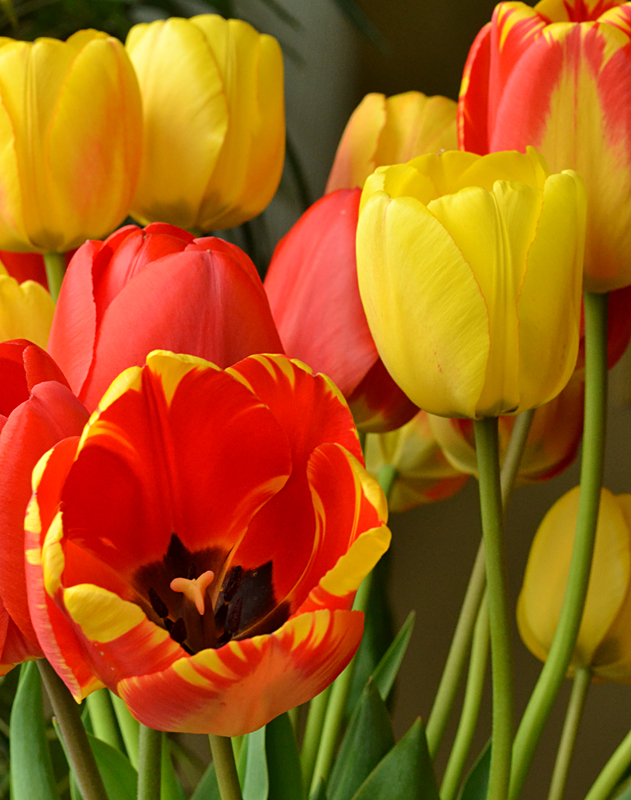
by Connie Oswald Stofko
“Winter is too long,” said David Clark, horticulturist and national garden speaker.”With our Western New York winters, it’s nice to have something pop up in mid- to late winter.”
That’s why he recommends planting spring bulbs– The first ones can come up when there’s still snow on the ground.
“I like to have a big show in spring,” Clark said. “And if you plan it correctly, you can have flowers from mid-winter through July when you plant bulbs.”
If you want a dazzling springtime show of flowers, fall is the time to plant the bulbs. Clark shares some tips with us in this article, and he will give you more details in his talk “Superior Spring Flowering Bulbs” at Lockwood’s Fall Garden Fair to be held from 9 a.m. to 4 p.m. Saturday, Sept. 6 and 10 a.m. to 3 p.m. Sunday, Sept. 7 at Lockwood’s Greenhouses, 4484 Clark St., Hamburg. The entire speaker schedule is below.
Lecture prices are $40 for both days, $25 for one whole day or $10 for each lecture. Pre-register online, by calling 649-4684 or in person at Lockwood’s.
In addition to the speakers, vendors will be selling pottery, watercolors, jewelry, wood crafts, glass, copper and unique garden items. I’ll have a booth there, too, so stop by and say hello!
Speakers and their topics are:
Saturday, Sept. 6
9:30 a.m. Lyn Chimera (Lessons from Nature) Fall Plants for Birds, Bees and Beauty
11 a.m. Sally Cunningham (Gardening expert) Extraordinary Gardens of Summer 2014
1 p.m. Mike Masterson (Masterson’s Garden Center) Honey Bees and Bee Keeping
2 p.m. Mike Frank (Chevalier Landscaping) Outdoor Living
Sunday, Sept. 7
10:30 a.m. Marge Vogel and Donna Connelly (Lockwood’s staff) Overwintering Annuals and Houseplants
11:30 a.m. David Clark (National horticulture speaker) Superior Spring Flowering Bulbs
1 p.m. Tom Szulist (Singer Farms) Garlic, Cherry Juice and Healthful Eating
See descriptions of the talks here.
Here are tips from David Clark on planting spring bulbs:

How to get flowers from mid-winter through July
Plant spring-flowering bulbs that bloom at different times.
Snow drops are the earliest, coming up in mid- to late winter. They’re reliable and prolific and can spread rapidly to the point of being a pest, Clark said.
Next come crocuses and scilla, a little blue flower that blooms in late winter to early spring.
Daffodils bloom in mid-spring. Tulips come a few weeks later.
Asiatic lilies bloom in early to mid-summer.
When to plant
Plant your spring-flowering bulbs in mid-September through mid-October, Clark said. You don’t want to wait much longer than that because you want to give the bulbs enough time to form good, strong roots, he explained.
You don’t want to plant too early, either. If the soil isn’t cool enough (around 50 degrees Fahrenheit) the bulb might start to send out stems or leaves. When the frost comes, it will damage the plant. That’s why garden centers are just starting to stock bulbs now. Lockwood’s will have bulbs for purchase at the Fall Garden Fair.
If you buy bulbs and can’t get them into the ground right away, you can store them for a couple weeks in a cool place such as a refrigerator, Clark said. Every time you open and close the fridge door, it forms a draft, and that moving air can dry out the bulbs. To protect them, place the bulbs in a paper bag in the crisper drawer.
Warning: Don’t store spring bulbs in your refrigerator if you have apples in there, he said. Apples release ethylene gas, which can kill the embryonic flower inside the bulb.
If you already have an established bed of spring-flowering bulbs, mid-September through mid-October is also a good time to separate and replant bulbs, such as the trio you see in the center of the illustration below.

How to plant
Plant the bulb pointy part up, Clark said. Don’t worry too much if you plant it upside down; the stem will still grow up through the ground. Through geotropism, the plant orients to gravity and sends roots down and the flower spike up.
However, the plant may have to expend more energy to curve the stem around. That might delay its flowering and the flower may not come back as reliably.
You should plant most bulbs to a depth two times the height of the bulb. For a bulb that’s two inches high, plant it at least four inches deep.
For Asiatic lilies, plant to a depth that is three to four times the height of the bulb.
Spring-flowering bulbs don’t like to sit in wet, clay soil, which is what 99 percent of us Western New York gardeners have, Clark noted. When you dig the hole, fill it with a 50/50 mixture of soil and compost. You can add sand, too.
A note about tulips
If you had a spectacular tulip bed a few years ago but it seems to be less showy each year, you might not be doing anything wrong. While we think of tulips as perennial plants, hybridized tulips will grow reliably for only about three years, Clark said.
When tulips plants were developed to have a large showy flower, the plant lost some of its reliability. Tulips with very large flowers may bloom only one year.
In the Netherlands, gardeners throw out their tulip bulbs rather than devote space to an under-performing bulb, he said.
In his talk, Clark will present more on spring-flowering bulbs, including how to fertilize them, how to protect them from squirrels and other pests, how to hide bare spaces later in the season and how to use them in containers.



David, I hope readers realize how much more they will learn when they attend your talk!
Connie-
Thank you for the great article!!
Kind Regards,
David Clark
Bulbs are ordered and come October will be in the ground. I depend a lot on bulbs for color throughout the growing season, good information so that more can benefit as well.